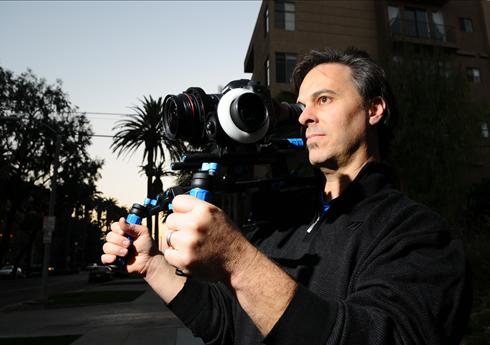Jefferson Graham
USA Today

Brian Valente, a partner with Redrock Microsystems, uses a Redrock EyeSpy rig to hold his camera stable while shooting video at the Santa Monica Pier around sunset. By Bob Riha Jr., USA TODAY
LOS ANGELES — Alex Buono, director of photography for NBC‘s Saturday Night Live, wanted a new look for the show’s opening video credits this year. He went to an unlikely source: a digital SLR camera from Canon.
Several models, such as the $2,499 EOS 5D Mark II and $1,699 EOS 7D, shoot high-quality stills and video that fans like Buono say look as good as a $10,000 video camera. “There’s nothing like it in the video world to even compare it to,” says Buono. “The image sensors are massive, and the images are amazing.”
But he quickly learned that he couldn’t just take the camera out of the box and start shooting. To maintain a steady image and proper focus, he reached for accessories that soup up the digital SLR/video hybrids (called VDSLRs) to turn them into super video cameras.
He opted for a loupe accessory for the LCD, which magnifies the image. “It would be impossible to focus without it,” says Buono.
About 2.7 million digital SLRs worth about $1.7 billion — many with video capability — will be sold this year in the United States, predicts market tracker IDC. And now there’s a boom in accessories to feed the trend.
Companies such as Dallas-based Redrock Microsystems and Chicago’s Zacuto are targeting VDSLR shooters. Their “rigs” are showing up prominently in the video departments at camera stores.
Simply pushing a camera’s record button isn’t enough if you want something “with some artistic merit,” says Brian Valente, a partner with Redrock. “The things we take for granted in a basic consumer video camera just aren’t there in the digital SLR.”
Some of the shortcomings and their problem-solving accessories:
•Controlling composition. You compose video through the camera’s LCD screen in “Live View” mode, similar to how you compose stills on a point-and-shoot. That makes it harder to focus and to compose correctly in low light.
Solution: LCD loupes from Hoodman, Zacuto or Cavision give you an eyepiece-like ability to compose. Prices range from about $80 to $375. Redrock and Zacuto also sell focus attachments for the camera body that allow for more precise focusing.
•Camera shake. The cameras are hard to hold steady for extended periods. Unlike video cameras, which tend to be heavier and easier to hold steady, the shakes really show up in VDSLRs.
Solution: “Steady rigs” from Redrock and Zacuto mount to the camera and help stabilize the image. The rigs rest on your shoulder.
•Sound. Audio from built-in microphones is inferior, and unacceptable for serious work. The 5D and 7D have mike inputs but higher-end microphones won’t fit.
Solution: David Speranza, who blogs about professional video for the website of New York retailer B&H Photo, recommends two small accessory microphones, the $200 Sennheiser MKE 400 and the $150 Rode VideoMic. Both plug into the mike jack, rest on the camera hot shoe and provide excellent sound, he says.
Speranza says VDSLR accessories are a big growth area for B&H. “There’s lots of interest in it. People who couldn’t conceive of shooting video that looked this good two years ago can now get amazing results for under $2,000.”
The cameras shoot directly to memory cards, but you’ll need a big one to hold the footage — an 8-gigabyte or 16-GB card is a must.
That dreamy look
Speranza says the 7D is far and away the best-selling VDSLR, because of its lower price and because it can record video in variable frame rates. The 5D shoots at 30 frames per second, standard for video, while the 7D can do 30 frames or 24 frames, similar to film. “It has that dreamy look that filmmakers love,” he says.
This week Canon announced another new VDSLR that can shoot 1080p video, at its lowest price yet. The $799 (body only) EOS Rebel T2i, out in March, has the same 18 megapixel image sensor as the 7D.
The image sensor on these cameras is much bigger than those found on video cameras. So it can produce images with shallow depth of field (blurry backgrounds) on a multitude of lenses.
“You’ve got sensors that are six to eight times the size of what you’ll find in video cameras,” says Syl Arena, a California photographer who recently used the 5D Mark II to shoot footage for a TV reality show pilot. “You get a cinematic look that is just amazing.”‘
Nikon introduced video to SLRs in 2008 with the D90. But video really took off for advanced amateurs, pros and indie productions with Canon’s 5D Mark II and 7D, which both shoot full 1080p high-definition video.
Besides Saturday Night Live, the Fox series 24 has shot scenes with the 5D. And the recent Terminator Salvation movie ran a series of Internet episodes promoting it that were all done with the 5D.
Shane Hurlbut, director of photography for Salvation, just finished making a feature film about the Navy SEALs using 5Ds, with Redrock gear to mount cameras for handheld use.
“It puts the viewer directly into the action,” he says. “With this technology, you feel like you’re in a video game.”

